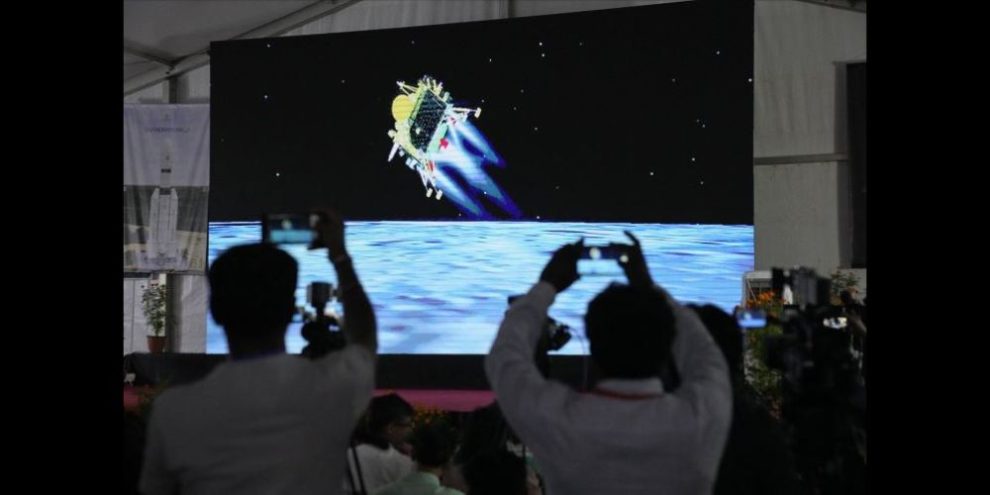
By Ashok Sharma And Krutika Pathi in New Delhi
India on Wednesday made history as it became the first country in the world to land a spacecraft near the moon’s south pole, an uncharted territory that scientists believe could hold vital reserves of frozen water, and the fourth country to achieve a moon landing.
A lander with a rover inside touched down on the lunar surface at 6:04 local time, sparking cheers and applause among the space scientists watching in the southern Indian city of Bengaluru. After a failed attempt in 2019, India now joins the United States, the Soviet Union and China in reaching this milestone.
Indian Prime Minister Narendra Modi watched the historic landing from South Africa, where he is participating in the BRICS nations summit. “India is now on the moon. India has reached the south pole of the moon — no other country has achieved that. We are witnessing history,” Modi said as he waved the Indian tri-coloured flag.
S. Somnath, chairman of the state-run Indian Space Research Organization, or ISRO, said the rover will slide down a flap from the lander within hours or a day and conduct experiments, including an analysis of the mineral composition of the lunar surface.
The mission is expected to remain functional for two weeks, he said. He also said India would next attempt a manned lunar mission.
India’s successful landing comes just days after Russia’s Luna-25, which was aiming for the same lunar region, spun into an uncontrolled orbit and crashed. It would have been the first successful Russian lunar landing after a gap of 47 years. Russia’s head of the state-controlled space corporation Roscosmos attributed the failure to the lack of expertise due to the long break in lunar research that followed the last Soviet mission to the moon in 1976.
Excited and anxious, people across India, home to the world’s largest population, crowded around televisions in offices, shops, restaurants and homes. Thousands prayed Tuesday for the success of the mission with oil lamps on the river banks, temples and religious places, including the holy city of Varanasi in northern India.
After the landing, congratulations poured in from around the world, cementing India’s emergence as a modern space power.
“Your success will power the imagination and light the future of people around the world,” the U.S. State Department’s Bureau of Oceans and International Environmental and Scientific Affairs posted on X, formerly known as Twitter.
“Incredible!” European Space Agency’s director general Josef Aschbacher tweeted. “I am thoroughly impressed.”
NASA’s former science mission chief, Thomas Zurbuchen, who now works at ETH Zurich, a public research university in Switzerland where he is leading its space initiative, said he felt proud of the achievement.
India’s Chandrayaan-3 — “moon craft” in Sanskrit — took off from a launchpad in Sriharikota in southern India on July 14. Its landing marks a significant step forward for the nation's progress in space exploration, ISRO said in a statement earlier.
Many countries and private companies are interested in the south pole region because permanently shadowed craters may hold frozen water that could help future astronaut missions.
The six-wheeled lander and rover module of Chandrayaan-3 is configured with payloads that would provide data to the scientific community on the properties of lunar soil and rocks, including chemical and elemental compositions.
India’s previous attempt to land a robotic spacecraft near the moon’s little-explored south pole ended in failure in 2019. It entered the lunar orbit but lost touch with its lander, which crashed while making its final descent to deploy a rover to search for signs of water. According to a failure analysis report submitted to the ISRO, the crash was caused by a software glitch.
The $140-million mission in 2019 was intended to study permanently shadowed moon craters that are thought to contain water deposits and were confirmed by India’s Chandrayaan-1 orbiter mission in 2008.
With nuclear-armed India emerging as the world’s fifth-largest economy last year, Modi’s nationalist government is eager to showcase India’s rising standing as a technology and space powerhouse. A successful moon mission dovetails with Modi’s image of an ascendant India asserting its place among the global elite and would help bolster his popularity ahead of a crucial general election next year.
The anticipation for a successful landing rose after Russia’s failed attempt and as India’s regional rival China reaches for new milestones in space. In May, China launched a three-person crew for its orbiting space station and hopes to put astronauts on the moon before the end of the decade. Relations between India and China have plunged since deadly border clashes in 2020.
Numerous countries and private companies are racing to successfully land a spacecraft on the lunar surface. In April, a Japanese company’s spacecraft apparently crashed while attempting to land on the moon. An Israeli nonprofit tried to achieve a similar feat in 2019, but its spacecraft was destroyed on impact.
Japan plans to launch a lunar lander to the moon over the weekend as part of an X-ray telescope mission, and two U.S. companies also are vying to put landers on the moon by the end of the year, one of them at the south pole. In the coming years, NASA plans to land astronauts at the lunar south pole, taking advantage of the frozen water in craters.
NASA Administrator Bill Nelson tweeted via X: "Congratulations @isro on your successful Chandrayaan-3 lunar South Pole landing! And congratulations to #India on being the 4th country to successfully soft-land a spacecraft on the Moon. We’re glad to be your partner on this mission!”
Pallava Bagla, a science writer and co-author of books on India’s space exploration, said the Russian failure days earlier did put India off. He also said lessons learned from India’s failed mission four years ago were incorporated and a flawless mission was executed on Wednesday.
"Indians didn’t get derailed. They continued the journey with strength and confidence that paid off,” he said.
Banner image via The Associated Press





